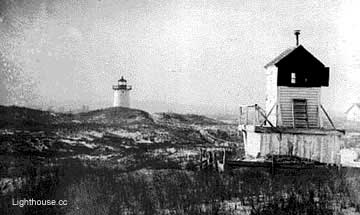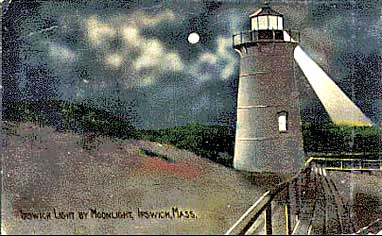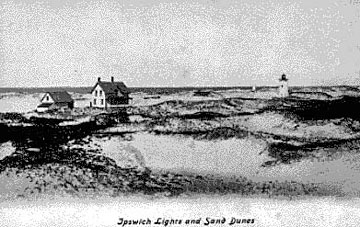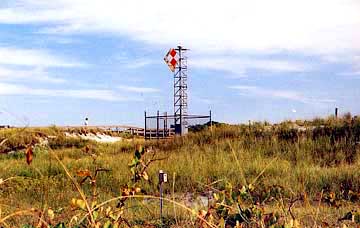|
FRESH STUFF DAILY |
|
|
||
|
|
||
|
|
||
|
SEE ALL SIGNED BOOKS by J. Dennis Robinson click here |
||
What follows is the story of a daring 1839 rescue in a fierce storm. Some were saved. Some died. A century later drifting sand was so high that ligthouse keepers had to enter through a window. Jeremy’s Lighthouse Guide #61
Because of increasing maritime traffic in the early 1800s, reliable aids to navigation to guide mariners to the Ipswich River on the northern Massachusetts coast became a necessity. After a congressional appropriation of $7,000 in 1837, two 29-foot brick lighthouses were built, along with a brick dwelling. The two lights served as a range for mariners, who would line them up as they headed through the main channel toward the mouth of the river.
The first keeper was Thomas Smith Greenwood, a native of Boston. Greenwood had gone to sea as a young man and eventually became the captain of clipper ships. He and his wife, Paulina Adams (Thurlow), had eight children. On December 23, 1839, the coast was hit by the second of what became known as the triple hurricanes of 1839. A Maine schooner, the Deposit, ran aground close to the light station. At dawn a neighbor, Joseph Marshall, alerted Greenwood, who ran to the scene to find that the remaining people on the vessel—including the captain’s wife—were clinging to the rigging. Two crewmen had already died. The situation appeared dire, but the terrified screams of the captain’s wife prompted Greenwood to make a desperate rescue attempt. The keeper instructed Marshall to hold one end of a 200-foot line. Tying the other end around himself, Greenwood swam through the icy waves and reached the schooner. Marshall tied the other end of the line to a lifeboat, which he then boarded and launched into the breakers. Greenwood pulled the lifeboat, with Marshall in it, to the schooner.
Greenwood first tried to save Captain Cotterill, who was barely alive. As the captain was being lowered into the lifeboat, a great wave hit and the man was lost, along with the lifeboat. The captain’s wife, witnessing her husband’s drowning, became hysterical. Greenwood and Marshall convinced the woman to jump from the rigging into their arms. Two other survivors managed to reach shore by clinging to wreckage; Greenwood, Marshall, and the captain’s wife were carried safely to shore by a great wave. Captain Cotterill and three crewmen who died in the wreck were buried in Ipswich a few days later.After a congressional appropriation of $7,000 in 1837, two 29-foot brick lighthouses were built
Because the channel continually shifted, the towers had to be moved several times. At some point before 1867 the front light was replaced by a shanty-like affair known as the "bug light." By 1878 the rear tower was badly cracked, and the dwelling was severely deteriorated. A new dwelling was completed in 1880, and a new rear range tower was erected the following year. It was a 45-foot, conical cast-iron tower similar to several built in New England during the 1870s and 1880s. Succeeding Greenwood in 1861 was Benjamin Ellsworth, a native of nearby Rowley. Ellsworth would stay until he was nearly 90 years old, a beloved local fixture and faithful public servant. The front range light was discontinued for good in 1932, and the rear tower was automated. By 1938 the sand was so high around the tower that maintenance personnel had to enter through a window high up on the tower. It was decided that a simple steel skeleton tower would be easier to maintain, and there would be no worry if sand built up around its base.
In 1939 the iron lighthouse was floated by barge to Edgartown on Martha’s Vineyard to replace an earlier structure that had been badly damaged in the hurricane of September 1938, and the lighthouse in Ipswich was replaced by a utilitarian skeleton tower. Other than the modern steel light tower at Crane Beach, there is no longer any reminder of this old light station in Ipswich. You can read more at Jeremy’s website at lighthouse.cc and also in his upcoming book, The Lighthouses of Massachusetts, due in June 2007.
Copyright 2007 by Jeremy D'Entremont,New England Lighthouses.
Please visit these SeacoastNH.com ad partners.
News about Portsmouth from Fosters.com |
| Saturday, April 20, 2024 |


|
Copyright ® 1996-2020 SeacoastNH.com. All rights reserved. Privacy Statement
Site maintained by ad-cetera graphics





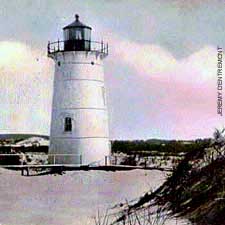 Ipswich, MA
Ipswich, MA